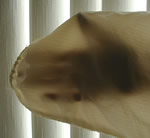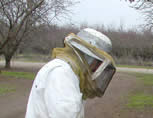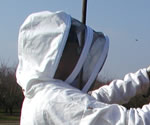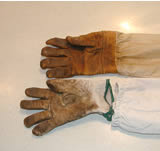The most important single protective item a person can wear when around bees is a hat. Bees associate hair with their natural enemies like bears or mice and once entangled in hair, almost always end up stinging. Bee suits, of course, are better because they protect your hair and most everything else.
Bee suits are traditionally made of cotton as it is a heavy enough fabric bees can't sting through it. A more recent development is a thin light weight nylon fabric bees can easily sting through, but because of it's slick non porous texture, the bees don't recognize it as skin or anything worthy of their sting. Shown at right, it is a much lighter weight fabric and cooler in hot weather.




